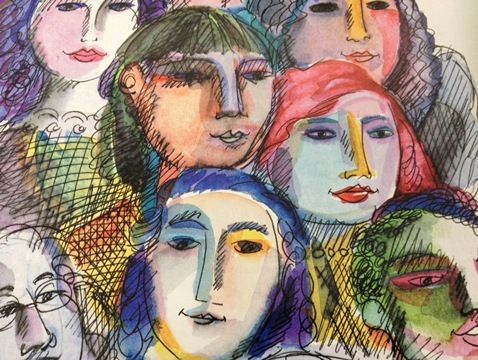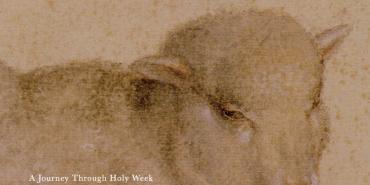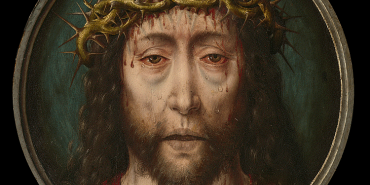Your Daughters Shall Prophesy

A look at the historical contributions of women to the church reveals the key behind this early acceptance of their voices and gifts - the concept of an apostolic ministry.
Anna Hanscome's resolve to establish a stable holiness work in Malden, Massachusetts, led to the founding in 1890 of one of the Church of the Nazarene's 10 oldest congregations. The Central Evangelical Holiness Association (CEHA), our New England root, ordained her in 1892, and pastored at Malden until her death. Rev. Hanscome was one of the first women ordained in America and the first by any Nazarene parent body. The CEHA merged with the Association of Pentecostal Churches of America in 1896, and Susan Fitkin, Martha Curry, and other preaching women soon united with it. Rev. Curry was ordained in 1902.
In the South, Susie Sherman and Emma Woodcock preached daily for two months beside Robert Lee Harris in a Tennessee revival that launched the New Testament Church of Christ in 1894. Mary Lee Cagle and Mrs. Elliot J. Sheeks were ordained by its Eastern Council in 1899. Rev. Cagle had already organized a circle of churches near Abilene, Texas, that formed the nucleus of today's West Texas District.
In east Texas, Independent Holiness Church preacher Johnny Hill Jernigan was ordained in 1902 in the same service as C. B. Jernigan, her husband. The merger of these Southern groups in 1904 was followed by the publication of a remarkable book Women Preachers, edited by Fannie McDowell Hunter, pastor in Rising Star, Texas. The book featured nine women's 'call narratives' and marshaled arguments defending women's public ministry. By 1908, one sixth of the 178 ordained ministers in the Holiness Church of Christ were women.
On the West Coast, Phineas Bresee employed Amanda Berry Smith, a noted preacher, as the evangelist at Los Angeles' Asbury Methodist Church in 1890. In 1895, under Bresee's guidance, Los Angeles First Church of the Nazarene provided at the time of its founding for women to preach. In 1902, Bresee ordained Elsie Wallace, founding pastor of Spokane, Washington, First Church. He ordained Lucy Knott, founding pastor of a second Los Angeles congregation, the next year.
Most denominations of that day severely restricted women's participation in church governance and ministry, even locally. But early Nazarenes opened every clergy and lay office to female initiative, whether at the local, district, or general level.
The concept of apostolic ministry - a simple but explosive idea, long since ignored - lay behind this openness to women's voices and gifts. The basis of apostolicity is that a belief or practice conforms to or reflects the belief and practice of the New Testament church.
The Wesleyan tradition's linkage of women with apostolic ministry stemmed from various sources, including John Wesley's conviction that the church is essentially 'the people of God,' not a clergy hierarchy, and that every Christian bears the gospel and is a minister in his or her own way. Grace Murray and Mary Bosanquet were among the lay people whom Wesley permitted to preach.
The 19th-century Wesleyan-Holiness Movement developed the idea further. Phoebe Palmer's Promise of the Father (1859) grounded women's right to preach in Peter's sermon on Pentecost and his resounding declaration: 'This is what was spoken of by the prophet Joel: 'In the last days, God says, I will pour out my spirit on all people. Your sons and daughters will prophesy'' (Acts 2:16-17). Thus the very gift of God's Spirit to the Christian Church establishes and empowers a gender-inclusive ministry, and if one gender is denied its apostolic right to preach, the Spirit, who calls the Church into being, also is denied.
Wesleyan Methodist leader Luther Lee emphasized Galatians 3:28 as the basis for women's ministry, as did Catherine Booth, Salvation Army cofounder, in Female Ministry or, Woman's Right to Preach the Gospel. The Nazarene founders, steeped without exception in this exegetical heritage, defended the practice of ordaining women by drawing freely on Peter and Paul alike.
Thus Bresee's declaration to the Second General Assembly's Manual revision committee had specific content behind it. Asserting that the Church of the Nazarene had an apostolic ministry, he argued that women's right to preach and pursue ordination was sufficiently safeguarded so long as apostolicity was the hallmark of the church's ministry (J.B. Chapman, Herald of Holiness, October 15, 1930).
C. E. Brown, leader in another Holiness denomination, later summarized the conviction this way: 'The prevalence of women preachers is a fair measure of the spirituality of a church, a country, or an age. As the church grows more apostolic and more deeply spiritual, women preachers and workers abound in that church; as it grows more worldly and cold, the ministry of women is despised and gradually ceases altogether' (The Gospel Trumpet, May 27, 1939).
The inclusion of women was not simply an add-on to traditional notions of Christian ministry but represented an altogether a radically different doctrine of ministry held by the more progressive Holiness churches.
This intention to open wide the doors to women's leadership was celebrated publicly from the first. Lura Horton and Anna Cooley were among the seven new ministers ordained at the First General Assembly in Chicago (1907). The next year, at Pilot Point, TX, Mary Emily Ellyson was ordained beside R. T. Williams and Alpin Bowes at the Second General Assembly. Women subsequently assumed a wide variety of ministerial roles in Nazarene life.
Eight women on the Southern California District's 1922 clergy roll were missionaries: Myrtle Mangum and Lou Jane Hatch in India, Minnie Staples in Japan, Mrs. Harry Wiese in China, Pearl Ingram in Central America, and Etta Innis Shirley, Maud Cretors, and Louise Robinson in Africa. Esther Carson Winans was an ordained minister who relied on her pastoral experience during missionary service in Peru. Agnes Kanema Hynd, the Scottish missionary to Swaziland, was not only a medical professional but also an ordained minister, like her mother, Jane Sharpe of Glasgow.
Women shaped home missions as well. Maye McReynolds led the Church of the Nazarene into ministry to Hispanics. One of her converts in Los Angeles, Santos Elizondo, pioneered home mission churches in Texas and Mexico alike. Minnie Staples ministered among Japanese immigrants in Southern California before her missionary service in Japan, while Lillian Poole returned from Japan to start a Japanese-American ministry on the San Francisco District. Mary Lee Cagle planted First Church in Lubbock, Texas, and at least 21 other congregations in six states.
Scores of women have been Nazarene evangelists. Minnie Ludwig conducted revivals with her husband, Theodore. Joy and Mary Latham were full-time evangelists before joining the Nazarene Headquarters staff. Juliet Ndzimandze conducted revivals throughout Swaziland before her ministry took her across a wide swath of Africa. Dell Aycock, Nettie Miller, Elizabeth Vennum, and Nettie Hudson are among the revivalists whose voices once resounded from Nazarene pulpits.
And there were pastors. Agnes Diffee, senior pastor of Little Rock First Church for 18 years, was renowned throughout Arkansas and led one of the denomination's largest congregations. The Lufkin, Texas, church led by Emma Irick was the Houston District's largest. Rosa Lee served nearly a decade as pastor of her district's largest church when she became superintendent of the Leeward/Virgin Islands District.
Bessie Dillingham, grandmother of Focus on the Family executives James Dobson and H. B. London Jr., copastored 10 churches with her husband, M. V. Dillingham, including Shreveport, Louisiana, First Church and Oklahoma City First Church. Like many clergy couples, they divided the preaching responsibilities, and 'Sister Dill' usually preached an evangelistic sermon at the Sunday evening service. Lucy Knott, Martha Curry, Elsie Wallace, and many others devoted their lives largely to pastoral ministry.
Many women followed the call as educators. Mary Emily Ellyson taught in the religion departments of several Nazarene colleges. Maude Stuneck's religion classes at Trevecca 'were always packed out,' according to Mildred Bangs Wynkoop, and she also contributed to the Beacon Bible Commentary. New Testament specialist Olive Winchester, the first woman ordained in Scotland by any denomination, taught religion at Northwest Nazarene College, where she also was academic dean and vice president, and at Pasadena College.
Mildred Bangs Wynkoop served multiple roles: evangelist, missionary to Taiwan and Japan, and theological educator. Her Theology of Love remains a popular study in the theology of Christian holiness. Argentinian preacher Lucia Carmen Garcia de Costa was one of the most effective church planters in Nazarene history. In addition, she held a doctorate in linguistics and taught at the Nazarene Bible College in Buenos Aires, and she translated Wesleyan theological texts into Spanish.
Does the Church of the Nazarene lay claim to an apostolic ministry today in a way that Bresee and other founders would honor? Rich Houseal studied the development of Nazarene women clergy in the United States and found that their ministerial opportunities increased throughout the 1920s and 1930s but experienced a sharp decline after the mid-1950s. According to his research, women pastored more than 230 Nazarene congregations in the United States as late as 1955. By 1985 they pastored only 52.
Gifted women with proven leadership skills testify to a call to ministry today but report that institutional doors appear shut to them. New forms of fundamentalism, a drive to join the evangelical mainstream, and the influence of conservative social and political movements upon the church have influenced the way women are viewed and the roles in which they are accepted today.
Our history points back to a solution. The recovery of a biblical understanding of apostolic ministry needs to be part of the church's theological task once again.
If our history teaches anything, it teaches that setting God's people free for ministry is one of the distinguishing hallmarks of the Wesleyan vision.
Stan Ingersol is manager of Nazarene Archives at the Nazarene Global Ministry Center in Lenexa, Kansas.
Holiness Today, March/April 2000
Please note: This article was originally published in 2000. All facts, figures, and titles were accurate to the best of our knowledge at that time but may have since changed.




